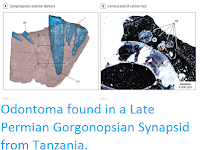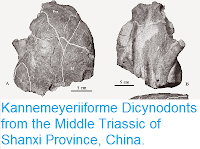Dicynodonts of the genus Lystrosaurus are one of the few large terrestrial animals to have made it through the End Permian Extinction. The genus was quite diverse in the Late Permian of Southern Africa, and is also known from the Late Permian of Russia. In the Triassic two species are known from South Africa, with other specimens recorded from China, India and Antarctica. The first of the Triassic South African species, Lystrosaurus murrayi, was first described by Thomas Henry Huxley in 1859, the second Lystrosaurus declivis, was described by Richard Owen in 1860. It was later suggested by the prominent South African palaeontologist Robert Broom that these were likely to be the same species, though most recent studies of the group have still regarded them as separate species.
A specimen of Lystrosaurus murrayi in the Musee d'Histoire Naturelle in Paris. Wikimedia Commons.
In a paper published in the South African Journal of Science on 27 March 2018, Francis Thackeray of the Evolutionary Studies Institute at the University of the Witwatersrand challenges the assumption that the two Triassic South African Lystrosaurus species are separate, on the basis of morphometric analysis.
Morphometric
analysis is a tool used by palaeontologists, archaeologists,
anthropologists and forensic pathologists to analyse and compare
specimens. It relies on taking numerous measurements of an object
such as a bone or shell, and comparing both these measurements and
ratios between measurements to those obtained from other specimens in
order to establish relationships between them. Traditionally these
measurements have been obtained using tape measures and callipers,
but modern scientists often use more sophisticated tools such as
structured light scanners, which are capable of building highly
detailed three dimensional models of specimens.
Specimen of Lystrosaurus declivis in the Musee des Confluences in Lyon. Wikimedia Commons.
Thackeray bases his analysis upon data previously published by Jennifer Botha-Brink, Daryl Codron, Adam Huttenlocker, Kenneth Angielczyk and Marcello Ruta in a paper published in the journal Scientific Reports in April 2016. This paper did not challenge the assumption that the two species were separate, but rather concentrated on the apparent breeding strategy of these species, noting that both had populations in which the largest specimens were rare, something often indicative of being able to breed before they reached full size, and suggests that this may have been a key adaptive trait that enabled these species to survive the End Permian Extinction.
Using the data provided by Botha-Brink et al., Thackeray takes this reasoning a step further and argues that the small difference in average size between the two species (with skulls averaging 0106.7 and 118.1 mm in length respectively) combined with the fact that most, if not all, specimens had not reached their maximum size, rules out any differentiation of the two species on the basis of size. He therefore suggests that all of these specimens should be referred to as Lystrosaurus murrayi, which was the first described and therefore has precedence.
See also...
See also...
Follow Sciency Thoughts on Facebook.








